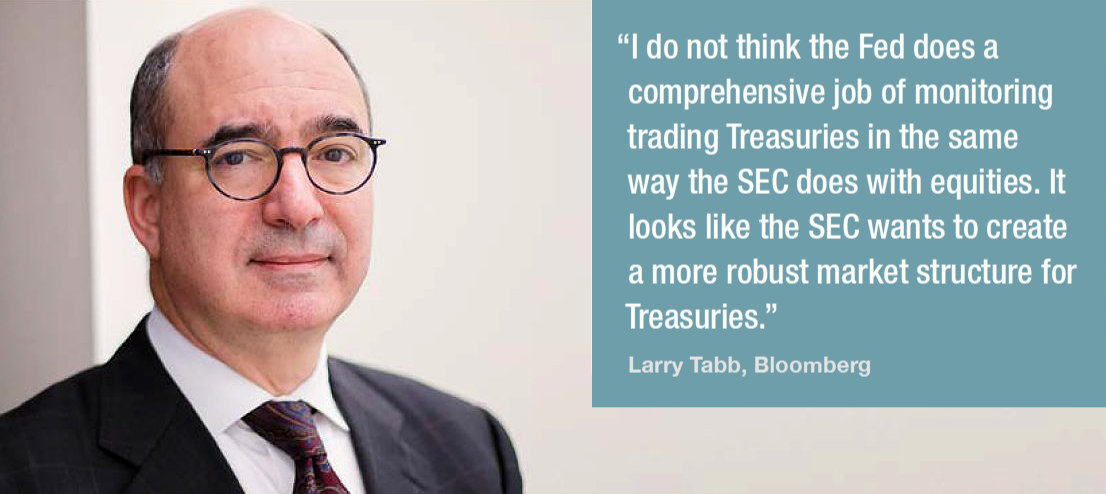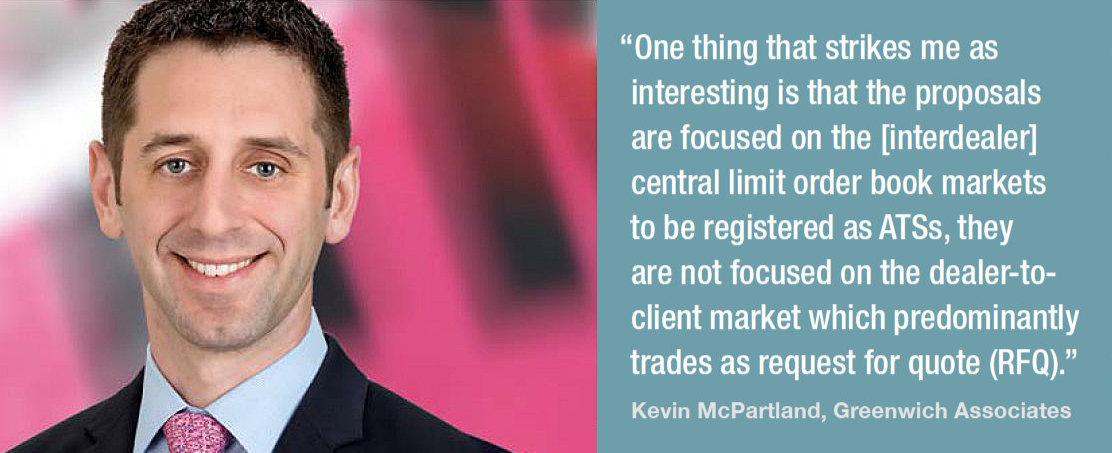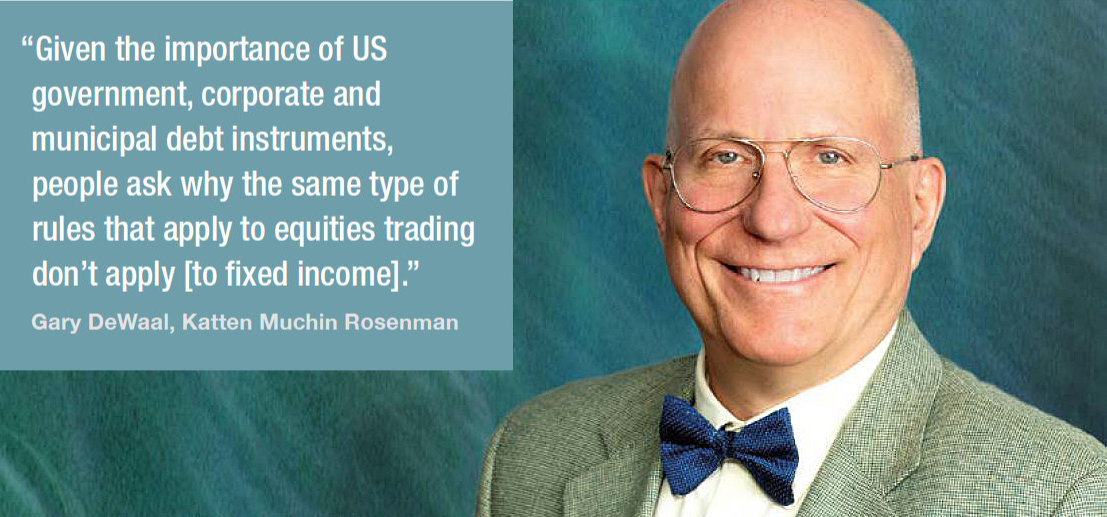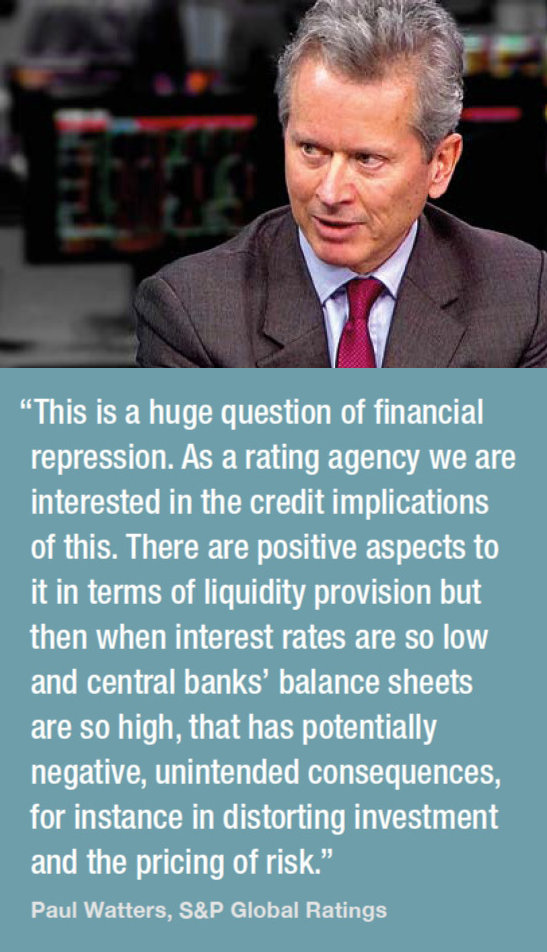 Transparency and structure is coming to the US Treasury and credit markets.
Transparency and structure is coming to the US Treasury and credit markets.
The role of the Fed is changing and consequently the role of other agencies is changing to fill the gaps. In 2021, there are expected to be reforms of the US Treasuries market structure and supervision.

“I think the US Treasury market has historically been governed by the Fed and the Treasury, and it looks like the Securities and Exchange Commission (SEC) is looking to take on a more hands-on approach,” says Larry Tabb, head of market structure research at Bloomberg intelligence. “That may have come out of Dodd Frank, and some arcane rules that came out of the global financial crisis, but under the proposal [to regulate Treasury trading venues] the SEC is absolutely trying to bring the Treasury market under the Exchange Act.”
US bond markets lack the defined structure of equity and futures markets, as they lack the link that exchanges provide to both as the primary market for a security to be issued on and the secondary market for that security to be traded afterwards.
Where NYSE and NASDAQ are self-regulatory organisations under US rules, and other exchanges are typically categorised as alternative trading systems (ATSs) or electronic communication networks (ECNs) the venues which allow bonds to be traded for the most part do not operate in the same way.
Consequently they have not been regulated; however in September 2020 the SEC proposed to “enhance the operational transparency, system integrity, and regulatory oversight for alternative trading systems (ATSs) that trade government securities as well as repurchase and reverse repurchase agreements on government securities,” by making government bond trading venues comply with Reg ATS, a set of rules that are commonly applied to trading venues for equity markets.
It also asked for comment on proposals to extend the regulatory framework for electronic platforms that trade corporate debt and municipal securities.

“One thing that strikes me as interesting is that the proposals are focused on the [interdealer] central limit order book markets to be registered as ATSs, they are not focused on the dealer-to-client market which predominantly trades as request for quote (RFQ),” says Kevin McPartland, Head of Research for Market Structure and Technology at analyst firm Greenwich Associates. “I guess regulating those markets is really capturing the low hanging fruit, as they fit fairly easily into the ATS rules whereas RFQ markets don’t.”
However, the SEC has expressly been addressing the corporate and municipal bond markets through its Fixed Income Market Structure Advisory Committee (FIMSAC), formed in November 2017.
Although the charter of FIMSAC says its “objectives and the scope of its activities are to provide the Commission with diverse perspectives on the structure and operations of the US fixed income markets, as well as advice and recommendations on matters related to fixed income market structure,” it has only ever advised on the corporate and municipal bond markets.
“As a member of FIMSAC and being on the Electronic Trading Committee, I had no advanced notice of SEC plans to formalise market structure on the Treasury side,” says Tabb. “FIMSAC has been more focused on corporates and munis.”
If the electronic interdealer platforms were brought under the purview of the SEC that might give it more authority to impose rules across all fixed income markets, creating a consistency of regulation.
It is a glaring inconsistency that bond trades for all other markets are published to the Trade Reporting and Compliance Engine (TRACE), run by self-regulatory organisation FINRA and made public, while Treasuries trades are not made public despite the Treasury market being a benchmark for other fixed income markets, and data being widely available for a fee.
Prior to the introduction of the requirement to publish data to TRACE, the US government was not able to view data on the trading of its own debt, although traders were.

“For years people have argued that the fixed income markets are critical to capital raising, not only for the federal government, but for private companies; yet trading in these markets is much more opaque than trading in equities,” says Gary DeWaal, special counsel at law firm Katten Muchin Rosenman. “Given the importance of US government, corporate and municipal debt instruments, people ask why the same type of rules that apply to equities trading don’t apply [to fixed income]. More importantly why doesn’t the same type of transparency apply; why is it not consistent even how we figure out what the volumes are, from one trading venue to another?”
This point was also addressed by FIMSAC for the credit and muni markets on 1st October 2020, with a recommendation for clearer reporting of electronic trading, as no consistent standard existed over the 20 venues handling corporate and municipal bonds.
“Investors in the e-trading venues, whether public or private companies, lack precise information on volume and market share trends for the various companies in the fixed income e-trading sector, making investing decisions more difficult,” the Committee wrote. “Further, without clear disclosure as to whether the various electronic trading volumes are limited to the retail, inter-dealer, or institutional customer markets, knowing whether electronic trading is bridging these disparate liquidity pools or whether they remain mostly separate is challenging.”
Taken together, the FIMSAC’s ongoing mission to support transparency and trading efficiency, and the SEC’s foray into the Treasury trading market, suggest a comprehensive move by the regulator to take a firmer grip on oversight of the credit and rates market across the US, potentially taking responsibility that is ostensibly managed by other authorities such as the Fed and its Treasury Market Practices Group (TMPG).
“It is probably not a bad thing;” says Tabb. “I do not think the Fed does a comprehensive job of monitoring trading Treasuries in the same way the SEC does with equities. It looks like the SEC wants to create a more robust market structure for Treasuries, based on the proposals.”
The complex structure of US market oversight
Regulatory supervision of North American capital markets is divided between many authorities. This has developed organically and a rationalisation of the authorities has never been seriously countenanced.
“Unlike in the UK where you have a single regulator, the Financial Conduct Authority mostly regulating market conduct, and a separate regulatory body regulating effectively the prudential aspects of the business, we in the US divide our prudential oversight of financial institutions among the Fed, the Treasury, the OCC, States as well as the SEC and CFTC,” says DeWaal. “Then on the conduct side we are divided between the SEC, CFTC and States with the increasingly important enforcement involvement of the Department of Justice. Frankly you are never going to have holistic regulation of financial markets in the US until you address the fundamental, to me, irrationality of the US financial regulatory structure.”
Having looser regulatory control in government bonds is relatively normal in any nation, because the tools for controlling inflation and the economy need to be controlled by the central bank and the government, and a legal impediment could create challenges.
“Certainly complexity of the oversight of the Treasury market could be streamlined,” say Tabb. “But there are reasons for that oversight. The US Government as the issuer of bonds wants to make sure there is enough liquidity, enough demand and their bonds are handled judiciously. The Federal Reserve acts as a liquidity agent, as well as a clearing agent for those bonds, then others such as the Office of the Comptroller of the Currency, have a view. But as the most traded fixed income security it deserves oversight.”
Yet central banks have now become involved in markets in ways that were not believed reasonable several decades ago, raising questions about who is overseeing who. Currently in developed markets they are setting low to negative interest rates, and then also buying up both government and corporate bonds which are issued at low rates to support businesses.
The Fed’s role in markets today
The Federal Reserve never engaged in its full capacity to buy bonds, based on the mandate given to it under the Covid-19 crisis in 2020. It has said it will continue to increase its holdings of Treasury securities by at least US$80bn per month and of agency mortgage-backed securities by at least $40bn per month
Nevertheless, there are many market observers who are concerned about the buying of corporate bonds and government bonds as a response to the March sell-off.
“Once you stop allowing volatility in the market, you have three objectives; low inflation, stabilising the economy and low volatility in the financial markets,” says one former central banker. “That last part becomes a rather sophisticated put; the put is, The Fed won’t allow firms’ gamma exposures to get bad.”
 Paul Watters, head of corporate research at S&P Global Ratings, says, “This is a huge question of financial repression. As a rating agency we are interested in the credit implications of this. There are positive aspects to it in terms of liquidity provision but then when interest rates are so low and central banks’ balance sheets are so high, that has potentially negative, unintended consequences, for instance in distorting investment and the pricing of risk.”
Paul Watters, head of corporate research at S&P Global Ratings, says, “This is a huge question of financial repression. As a rating agency we are interested in the credit implications of this. There are positive aspects to it in terms of liquidity provision but then when interest rates are so low and central banks’ balance sheets are so high, that has potentially negative, unintended consequences, for instance in distorting investment and the pricing of risk.”
If the central bank has taken the task of repressing volatility upon itself, but that volatility is only held back by its acquisition of bonds, the obvious question will be how reliant has the market become upon it as a backstop to volatility.
“It is certainly true of the Fed you can’t allow yourself to be too bothered about short term volatility,” says the former central banker. “Eventually they have got to get out of it. The question is can they get out of it in a tolerable and orderly way? With the emphasis on tolerably. I thought the ‘Taper tantrum’ was a small deal and the Fed’s reaction to that should have been ‘Whoops’, not to curl up and cry in a corner.”
Watters observes that the positive effect on liquidity is having a twofold effect on investors.
“Investors are having to stretch down the credit curve to reach certain yield and return targets that they might have,” he says. “So we certainly worry about the impact on leveraged finance where you have seen underwriting conditions, in the US, and with Europe not far behind, being very relaxed indeed considering the level of cov-lite and dividend re-cap activity. That plays into investors taking more risk for less security.”
The second issue is the potential masking of risk by supporting an overstretched market, which is not then obvious in the pricing that investors see.
“We would agree that there is a battle between the fundamentals and technicals in terms of market prices and what that is telling you relative to the credit fundamental side,” he says. “For instance when looking at the outlook for default risk.”
That said, bond investors have not seen a hit to the market when the Fed announced it would be pulling back from its bond buying – partly because it never got started.

“When they announced [the programme] we got the biggest market reaction, and actually [more] than when it went in place,” said Sonali Pier, portfolio manager for Multi-Sector Credit at PIMCO. “That took two months for the secondary market facility, and almost three months for the primary [market facility]. Then if you look at total capacity which was US$750 billion, they have only used US$13.92 billion of that. So the announcement was stronger than the action.”
Consequently the withdrawal of the programme is unlikely to have as direct an impact as the withdrawal of quantitative easing initially did with the ‘Taper tantrum’ in 2013.
“We already know that they are winding this down at the end of the year,” she said. “By now you would have seen a market reaction if the market couldn’t handle it. So I think at this stage it’s clear and fair to say that the market is taking it in its stride and wasn’t really dependent on it, from an aspect that it’s been under US$14 billion. Certainly, we would have loved to have had the safety, the backstop in place still, but I think that really all it was doing was curtailing some of that left tail risk.”
When the guy cornering the market is the supervisor
Looking across both corporate and government bond markets, the Fed has now taken a considerable position as the buyer of last resort.
“Market risk used to be held for the most part by banks and brokers,” says Tabb. “Hedge funds and buy-side firms with a little leverage dabbled around the edges, but by and large the only really levered players were the banks. Now the vast amount of liquidity is held by the central banks. The question becomes, if they are holding the vast amount of position do you really need a regulator? Should you have a third party who is not as tied in because the Fed balance sheet is US$7.5 trillion? It is being supervised by the guy cornering the market.”
There is nothing legally improper about this, but it does suggest that the SEC having a more focused agenda to supervise bond market activity could reduce risk, increase transparency, without any conflicts of interest developing.
“There are those who say; why are we looking to fix something that’s not broken?” says DeWaal. “The counter is; what is the justification for trading in equities securities being so transparent and alternative trading systems being subject to strict rules regarding disclosure of conflicts of interest, and open access, and why is that not the same for the fixed income securities?”
Tabb notes that the proposed changes would actually be easy to implement, given the relatively simple market structure and small size relative to equity markets.
“Can Treasuries be brought into more of an equity-like market structure? If any product can, Treasuries can,” he says. “There are less than 300 securities and most of the liquidity is in seven to 10 bonds.”
The existing regime of five agencies failed to find a cause for a 2014 flash crash, and failed to observe JP Morgan was manipulating the market under its nose, and had been since 2009, continuing to do so until 2016.
Even when caught in 2020 the bank was fined just US$10 million and a civil penalty of US$25 million to settle the action with the SEC, out of a total US$920 million in penalties and disgorgements, the Commodity Futures Trading Commission (CFTC) taking the lions’ share.
Tabb notes, “Now that the largest [Treasury] interdealer platform is owned by an exchange [the CME] it may make sense to bring it under exchange-type regulation, except the CME has generally been regulated by the CFTC and not the SEC.”
A lot has happened in US cash bond markets over the past decade. Much of it has not been subject to regulatory oversight. The appetite for change is said to have increased under the new regime, but experience suggests nothing will change overnight.
“I left the CFTC in 1986 and joined a small group of companies that included a government securities dealer; I remember because I had to register my firm as a government securities dealer at one point, and it was such a novel concept in the 80’s when I took on that task,” says DeWaal. “When I first joined you didn’t have to be registered to be a government securities dealer to act as one. This became a requirement in the US in 1987 only after passage of the Government Securities Act of 1986. The Securities Exchange Act was adopted in 1934, so it took more than 50 years to require entities that dealt with the public in government securities to also be registered. By that standard, efforts to enhance transparency in the governments securities market in 2020, is happening at light speed.”
©TheDESK 2021
©Markets Media Europe 2025












